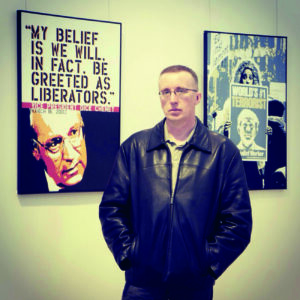Each issue the New Art Examiner will invite a well-known, or not-so-well-known, art world personality to write a speak-easy essay on a topic of interest – whatever it may be

Having dedicated my entire life from age 2 to the visual arts, I now feel that much of that life has been wasted, because my personal fortunes—like those of most artists—are at the mercy of the elite stewards entrusted with steering the fine art world, and they are a sorry lot indeed.
In November of 2012 the New York art gallery/museum elite came out in force to honor glamorous Russian socialite Dasha Zhukova who was awarded the *Independent Curators International* group’s prestigious “Leo” Castelli curator award, for the flimsy reason of bringing contemporary art (inoffensively uncritical of power structures) to the Russian Federation. Zhukova is the wife of controversial Russian billionaire Roman Abramovich, a Vladimir Putin-compliant oligarch currently based in London. Zhukova’s father is the lesser oligarch Alexander Zhukov, former Communist Party elite, accused arms dealer, and also closely connected to Putin. With help from her husband Zhukova opened the Garage Art Centre in Moscow, her stated goal being to “raise the profile of Russian Contemporary Culture internationally.“ But the silence from Zhukova was deafening about one infamous cultural event that occurred in Russia that same year. When all-girl Russian punk band Pussy Riot committed the grave sin of publicly embarrassing Putin—with their punk prayer performance at Moscow’s largest Orthodox cathedral—a show trial convened in August during which 2 band members were given custodial sentences. But Zhukova made no public statements about this Russian Contemporary Culture issue. Being a Putin-connected gallery owner in Moscow effectively renders Zhukova a censor of dissident art, as none of her curated exhibitions feature art that is remotely critical of Putin. Guilt by association may not be a crime here in America, but maintaining a conspiracy of silence with an oppressive police state should be construed as being complicit in censorship, ruling one out of the running for prestigious awards here in the democratic west.
But it seems that pandering to autocratic regimes does not have negative consequences for those wishing to mingle among New York’s gilded elites, because awards are no longer earned for accomplishment, but rather upon the basis of whom one knows?
Given Zhukova’s access to near limitless funds, her accomplishments should be considered mediocre. Asked in an interview (by Robert Frank at the Wall Street Journal) who her favorite visual artists were, Zhukova was unable to remember any names, and still she was invited to sit on the board of trustees of LACMA (Los Angeles County Museum of Art). Zhukova’s qualifications for this position are laughable, even if one considers her substantial financial resources.
Zhukova and Abramovich have sought to purchase respectability in the West via the fine art world. The ICI event of November 19th, 2012 must be seen for what it was: an attempt by speculative gallery and museum curators to ingratiate themselves with Abramovich’s tainted wealth. His vast fortune—estimated by Forbes at $9.1 billion—was accumulated under the dubious circumstances of Russia’s lawless mid-1990s, when Soviet state assets were sold off at knockdown prices to closely connected Kremlin insiders. Abramovich’s conspicuous propensity for ostentatious yachts, private jets, priceless works of art, and his high-spending ownership of Chelsea Soccer Club were judged by many as distastefully extravagant during the recent era of austerity. The ICI’s pursuit of Abramovich’s favor should be accompanied by critical scrutiny as to the source of his vast wealth.
While this game is still in play, many struggling artists here in America feel abandoned by the hegemony that is the top-heavy art-dealing elite who preside over an unregulated industry where the reputations of a select few artists (usually mediocre) are manufactured and inflated for maximum profit. In the art world success is rarely determined by the quality of the art, but rather by the influence of the artist’s connections, enhanced by hype and spin. The ICI’s time and resources would be better spent addressing the inequities of the art world by enabling struggling artists, instead of sucking up to the wealthy friends of dictators. I unsuccessfully lobbied the ICI to withdraw the Leo award from Zhukova for refusing to speak out against the Pussy Riot imprisonment.
The corporate news media must also be exposed for failing to highlight the ICI charade, despite my constant urging. But my greatest disgust is reserved for the establishment New York Times for refusing to print my op-ed (from which this current text is derived) not wishing to jeopardize their shrinking revenue sources I’m sure.
The shameless behavior by the beautiful people of NYC’s art gallery/museum elite was mirrored by the non-coverage in our corporate news media. Two brave young ladies rotting in Russian penal colonies also revealed the stark contrast between the consequences of running afoul of Putin and the benefits of being a close family friend and associate of the brutal Russian dictator, as Zhukova well knows.
Shay Culligan is a graduate of Boston’s Massachusetts College of Art, and has exhibited widely as a painter and photographer. Shay is an outspoken critic of the fine art establishment and its elite dealership culture which he claims peddles overrated mediocrity for vast sums at the expense of 99% of visual artists. Genetically incapable of pandering to any form of unjust establishment, Shay thrives in his role as an outsider artist, which he claims ultimately to be the essence of visual creativity.
Do you have something to say? Write to the editor.
Volume 30 number 1 August / September 2015 pp 16-17
